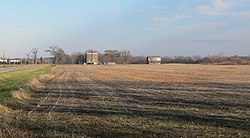Old Kaskaskia Village | |
 Old Kaskaskia Village site, seen from the west. Now an archeology site, the village thrived in the late 1600s. In the background left of center is the 1849 Sulphur Springs Hotel. The Illinois River is about 1,000 feet (300 m) south (right) of the road at left. | |
| Nearest city | Ottawa, Illinois |
|---|---|
| Coordinates | 41°19′17″N 88°58′04″W / 41.32139°N 88.96778°W |
| Built | 1673 |
| NRHP reference No. | 66000324 |
| Significant dates | |
| Added to NRHP | October 15, 1966[1] |
| Designated NHL | July 19, 1964[2] |
The Grand Village of the Illinois, also called Old Kaskaskia Village, is a site significant for being the best documented historic Native American village in the Illinois River valley. It was a large agricultural and trading village of Native Americans of the Illinois confederacy, located on the north bank of the Illinois River near the present town of Utica, Illinois. French explorers Louis Joliet and Father Jacques Marquette came across it in 1673. The Kaskaskia, a tribe of the Illiniwek people (and later, other Illiniwek tribes) lived in the village. It grew rapidly after a French mission and fur trading post (see, Illinois Country) were established there in 1675, to a population of about 6,000 people in about 460 houses.[3] Around 1691 the Kaskaskia and other Illiniwek moved further south, abandoning the site due to pressure from an Iroquois invasion from the northeast.[3]
The historic site is now owned by the U.S. state of Illinois. In the 1940s, historian Sarah Tucker of the University of Chicago was able to pinpoint the probable location of the village based on the historical record. The university and the Illinois State Museum conducted archaeological excavations and confirmed Tucker's research, finding substantial evidence of the village. The site was declared a National Historic Landmark in 1964.[2]
A prominent local landmark, Starved Rock, stands on the south bank of the river directly opposite the Grand Village site. Explorer La Salle founded a fort there to be near this village. Starved Rock is also a National Historic Landmark and is included in Starved Rock State Park.
- ^ "National Register Information System". National Register of Historic Places. National Park Service. January 23, 2007.
- ^ a b "Old Kaskaskia Village". National Historic Landmark summary listing. National Park Service. Archived from the original on September 9, 2010. Retrieved October 12, 2007.
- ^ a b "Old Kaskaskia Village Site". Survey of Historic Sites and Buildings. National Park Service. March 22, 2005. Retrieved October 13, 2007.


